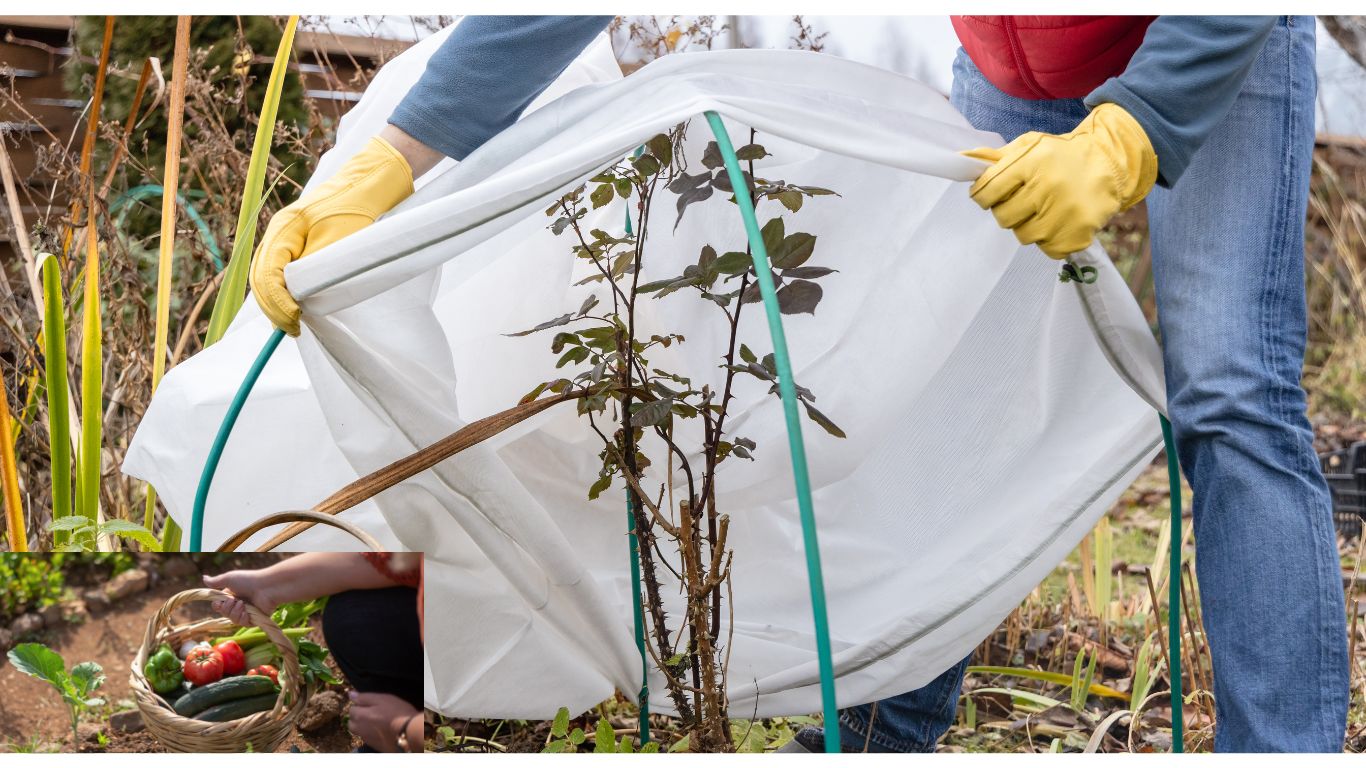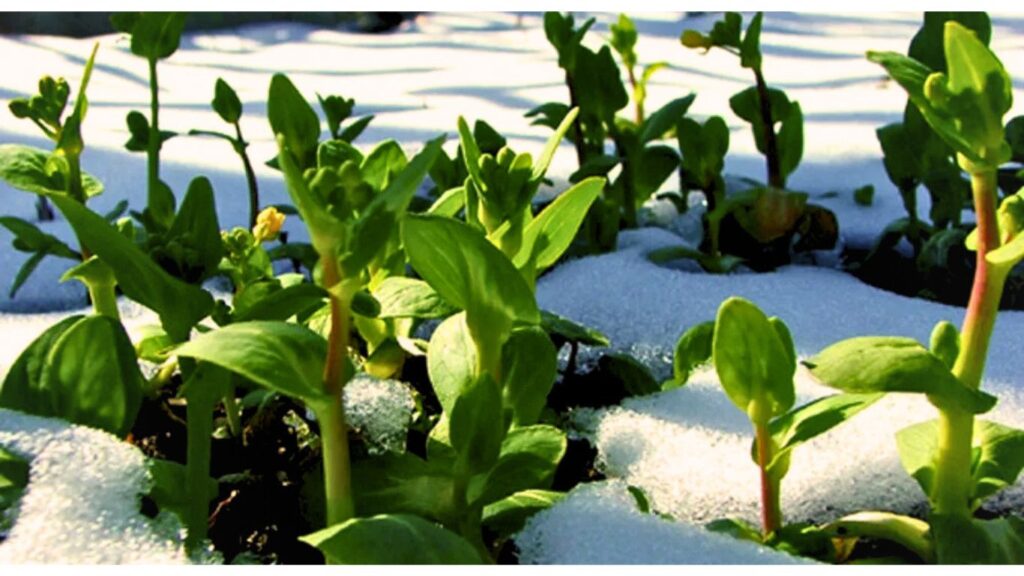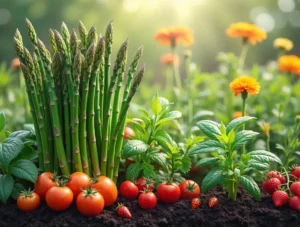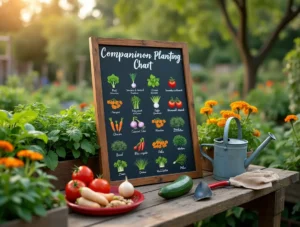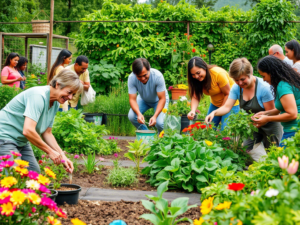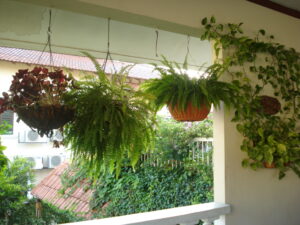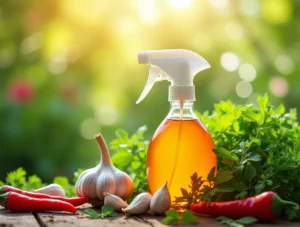As the temperatures drop and the days grow shorter, many gardeners assume it’s time to hang up their tools until spring. However, winter gardening offers a unique opportunity to stay connected to nature, grow fresh produce, and embrace sustainable living—even in the coldest months. Whether you’re a seasoned green thumb or a beginner, winter gardening can be both rewarding and eco-friendly. From protecting plants from frost to growing nutrient-rich greens indoors, this guide will show you how to cultivate a thriving winter garden while minimizing your environmental impact. Let’s explore how you can grow green in the cold season and make the most of your winter garden!
On This Page
Why Choose Sustainable Winter Gardening?
Winter gardening isn’t just about keeping your green thumb active during the colder months—it’s also an opportunity to embrace practices that benefit both the environment and your lifestyle. By choosing sustainable winter gardening, you can reduce your ecological footprint while enjoying fresh produce, healthier soil, and a more resilient garden.
Here are a few compelling reasons to go green with your winter gardening:
- Resource Conservation: Sustainable practices like composting, mulching, and water-saving techniques help conserve valuable resources, ensuring your garden thrives without waste.
- Environmental Impact: By avoiding synthetic fertilizers and pesticides, you protect local ecosystems and promote biodiversity, even in winter.
- Cost-Effective: Repurposing household items, making your own compost, and using natural frost protection methods can save money while reducing reliance on store-bought products.
- Year-Round Harvest: Growing cold-hardy vegetables and herbs in winter means fresh, homegrown food on your table, reducing the need for store-bought produce that often comes with a high carbon footprint.
- Soil Health: Sustainable practices like cover cropping and organic mulching improve soil structure and fertility, setting the stage for a thriving garden in spring.
- Connection to Nature: Winter gardening keeps you engaged with the natural world, offering mental and emotional benefits during the darker, colder months.
By adopting eco-conscious methods, you’re not just nurturing your garden—you’re contributing to a healthier planet. Sustainable winter gardening is a small but powerful step toward a greener, more self-sufficient lifestyle.
Planning Your Eco-Friendly Winter Garden
A successful winter garden starts with thoughtful planning. By taking a sustainable approach, you can create a garden that thrives in the cold while minimizing your environmental impact. Here’s how to plan your eco-friendly winter garden:
Choose the Right Plants
- Opt for cold-hardy vegetables like kale, spinach, carrots, and Brussels sprouts, which can withstand frost and provide fresh harvests.
- Include native plants that are adapted to your region’s winter conditions, requiring less water and maintenance.
- Consider evergreen shrubs or winter-blooming flowers like pansies and hellebores to add color and structure to your garden.
Maximize Space Efficiently
- If space is limited, try container gardening or vertical gardening to make the most of small areas.
- Use raised beds to improve drainage and extend the growing season by warming the soil faster in spring.
- Group plants with similar needs together to optimize water and resource use.
Prepare Your Soil Sustainably
- Enrich your soil with homemade compost or organic matter to boost fertility and improve structure.
- Practice no-till gardening to preserve soil microorganisms and prevent erosion.
- Use cover crops like clover or winter rye to protect and nourish the soil during the off-season.
Plan for Frost Protection
- Research DIY frost protection methods, such as cloches made from recycled bottles or row covers from old bedsheets.
- Strategically place plants in microclimates (e.g., near walls or under trees) to shield them from harsh winds and frost.
Incorporate Sustainable Tools and Materials
- Use recycled or repurposed materials for planters, trellises, and garden borders.
- Invest in durable, eco-friendly tools made from sustainable materials like bamboo or recycled metal.
Sustainable Frost Protection Techniques
Protecting your plants from frost is essential for a thriving winter garden, but it doesn’t have to come at the expense of the environment. With these sustainable frost protection techniques, you can shield your plants from the cold while staying eco-conscious:
1. Use Natural Mulches
- Spread organic mulches like straw, leaves, or wood chips around the base of plants to insulate the soil and retain heat.
- Mulching also helps conserve moisture and suppress weeds, making it a win-win for your garden.
2. DIY Plant Covers
- Create homemade cloches using recycled materials like plastic bottles, milk jugs, or glass jars.
- Use old blankets, burlap sacks, or bedsheets to cover plants overnight, removing them during the day to allow sunlight and airflow.
3. Build Cold Frames
- Construct cold frames from repurposed windows, wooden pallets, or scrap materials.
- These mini-greenhouses trap heat and protect plants from frost, extending the growing season.
4. Create Windbreaks
- Use natural windbreaks like evergreen shrubs, hedges, or trees to shield plants from harsh winter winds.
- Alternatively, set up temporary barriers using recycled materials like wooden planks or straw bales.
5. Utilize Microclimates
- Position plants in protected areas near walls, fences, or structures that absorb and radiate heat.
- South-facing spots often receive more sunlight and warmth, making them ideal for frost-sensitive plants.
6. Watering Strategically
- Water the soil (not the plants) in the late afternoon. Moist soil retains heat better than dry soil, providing warmth to plant roots overnight.
- Avoid overwatering, as soggy soil can lead to root rot in cold conditions.
7. Row Covers and Floating Row Covers
- Use reusable row covers made from lightweight fabric to protect plants while allowing light and air to pass through.
- Secure the covers with stakes or rocks to prevent them from blowing away.
8. Group Plants Together
- Cluster potted plants or garden beds together to create a warmer microenvironment.
- The collective heat from the plants can help them withstand colder temperatures.
Water Conservation in Winter Gardening
Water is a precious resource, and conserving it is a key aspect of sustainable gardening—even in winter. While plants may require less water during the colder months, it’s still important to manage water use efficiently. Here are practical tips for water conservation in winter gardening:
1. Monitor Soil Moisture
- Check soil moisture regularly before watering. Overwatering in winter can lead to root rot and other issues.
- Use a moisture meter or simply stick your finger into the soil to gauge if watering is necessary.
2. Water Strategically
- Water plants in the morning to allow excess moisture to evaporate during the day, reducing the risk of frost damage at night.
- Focus on watering the base of plants rather than the leaves to minimize evaporation and prevent fungal diseases.
3. Use Mulch to Retain Moisture
- Apply a layer of organic mulch (e.g., straw, leaves, or wood chips) around plants to lock in soil moisture and reduce the need for frequent watering.
- Mulch also helps regulate soil temperature, protecting plant roots from extreme cold.
4. Collect and Use Rainwater
- Set up rain barrels to collect and store rainwater for winter gardening.
- Rainwater is free of chemicals and ideal for watering plants, even in colder months.
5. Install Drip Irrigation Systems
- Use a drip irrigation system to deliver water directly to plant roots, minimizing waste from evaporation or runoff.
- Drip systems are efficient and can be easily adjusted for winter use.
6. Group Plants by Water Needs
- Arrange plants with similar water requirements together to avoid overwatering or underwatering certain areas.
- This practice, known as hydrozoning, ensures efficient water use.
7. Reuse Household Water
- Collect and reuse greywater from activities like rinsing vegetables or boiling pasta (as long as it’s free of soap and chemicals).
- This reduces waste and provides an additional water source for your garden.
8. Protect Soil Structure
- Avoid compacting soil by walking on wet garden beds, as compacted soil reduces water absorption and increases runoff.
- Use raised beds or designated pathways to minimize soil disturbance.
9. Choose Drought-Tolerant Plants
- Incorporate cold-hardy, drought-tolerant plants that require less water, such as kale, Swiss chard, or certain herbs.
- These plants are well-suited for winter gardening and reduce the need for frequent watering.
10. Cover Bare Soil
- Use cover crops or mulch to cover bare soil in unused garden beds. This prevents water loss through evaporation and improves soil health.
Sustainable Winter Composting
Composting doesn’t have to stop when the temperature drops! Sustainable winter composting is a great way to recycle kitchen and garden waste, enrich your soil, and reduce landfill contributions—even in the coldest months. Here’s how to keep your compost pile active and eco-friendly during winter:
1. Choose the Right Compost Bin
- Use an insulated compost bin or a covered tumbler to retain heat and speed up decomposition.
- If using an open pile, cover it with a tarp or thick layer of straw to protect it from snow and freezing temperatures.
2. Balance Green and Brown Materials
- Maintain a healthy mix of green materials (nitrogen-rich, like vegetable scraps, coffee grounds, and fresh plant waste) and brown materials (carbon-rich, like dried leaves, straw, and cardboard).
- Aim for a ratio of about 1 part green to 3 parts brown for optimal decomposition.
3. Chop or Shred Materials
- Cut kitchen scraps and garden waste into smaller pieces to speed up the composting process.
- Smaller particles break down faster, even in colder weather.
4. Keep the Pile Active
- Turn your compost pile regularly to aerate it and distribute heat evenly.
- If the pile freezes, wait for a warmer day to turn it and reactivate the decomposition process.
5. Add Insulation
- Surround your compost bin or pile with straw bales, leaves, or old blankets to trap heat and keep the interior warm.
- Place the compost bin in a sunny spot to take advantage of natural warmth.
6. Use Kitchen Scraps Wisely
- Collect kitchen scraps in a countertop compost bin and add them to your pile regularly.
- Avoid adding meat, dairy, or oily foods, as they can attract pests and slow down composting.
7. Incorporate Worms (Vermicomposting)
- Set up an indoor worm bin for vermicomposting during winter.
- Red wigglers can process kitchen scraps efficiently, producing nutrient-rich worm castings for your garden.
8. Monitor Moisture Levels
- Keep your compost pile moist but not soggy. Winter winds and indoor heating can dry out the pile, so add water sparingly if needed.
- Cover the pile to prevent excess moisture from rain or snow.
9. Start a Bokashi Bin
- Try Bokashi composting, an anaerobic process that ferments kitchen waste indoors.
- Bokashi bins are compact, odor-free, and work well in winter, producing pre-compost that can be buried in garden beds later.
10. Plan for Spring Use
- Even if your compost pile slows down in winter, it will break down more quickly as temperatures rise in spring.
- Use the finished compost to enrich your garden soil, giving your plants a healthy start for the growing season.
Eco-Friendly Pest Management in Winter
Winter may seem like a time when pests disappear, but some can still threaten your garden—or even move indoors! Managing pests in an eco-friendly way ensures your plants stay healthy without harming the environment. Here are sustainable strategies for eco-friendly pest management in winter:
1. Identify Common Winter Pests
- Outdoor Pests: Aphids, slugs, snails, and overwintering insects like cabbage worms.
- Indoor Pests: Spider mites, fungus gnats, and whiteflies that thrive on houseplants.
- Understanding the pests you’re dealing with is the first step to managing them effectively.
2. Encourage Natural Predators
- Attract beneficial insects like ladybugs and lacewings, which feed on aphids and other pests.
- Provide habitats for birds by setting up feeders or birdhouses; they’ll help control insect populations.
3. Use Organic Pest Repellents
- Spray plants with neem oil, a natural pesticide that disrupts pests’ life cycles without harming beneficial insects.
- Create a DIY garlic or chili pepper spray to deter pests from munching on your plants.
4. Practice Crop Rotation and Diversity
- Rotate crops in your garden to prevent pests from becoming established in one area.
- Plant a diverse mix of species to reduce the risk of pest infestations.
5. Keep Your Garden Clean
- Remove dead leaves, plant debris, and fallen fruit where pests can hide and breed.
- Regularly inspect plants for signs of pests and address issues early.
6. Use Physical Barriers
- Cover plants with floating row covers to protect them from pests while allowing light and air to pass through.
- Place copper tape around pots or garden beds to deter slugs and snails.
7. Introduce Beneficial Nematodes
- Apply beneficial nematodes to the soil to control overwintering pests like grubs and larvae.
- These microscopic worms are safe for plants, humans, and beneficial insects.
8. Manage Indoor Pests Naturally
- For houseplants, use sticky traps to catch flying pests like fungus gnats.
- Wipe leaves with a damp cloth to remove spider mites and other small pests.
- Avoid overwatering indoor plants, as damp soil attracts pests.
9. Companion Planting
- Grow pest-repellent plants like marigolds, garlic, or basil alongside your vegetables or houseplants.
- Companion planting can naturally deter pests and improve plant health.
10. Avoid Chemical Pesticides
- Steer clear of synthetic pesticides, which can harm beneficial insects, soil health, and the environment.
- Opt for organic, eco-friendly solutions that target pests without causing collateral damage.
Energy-Efficient Indoor Gardening Tips
Indoor gardening during winter is a great way to keep your green thumb active, but it can also lead to higher energy use if not managed sustainably. With these energy-efficient indoor gardening tips, you can grow healthy plants while minimizing your environmental impact and saving on energy costs:
1. Maximize Natural Light
- Place plants near south-facing windows to take advantage of the most sunlight during shorter winter days.
- Use reflective surfaces like mirrors or white walls to bounce light onto your plants.
- Rotate plants regularly to ensure all sides receive equal light exposure.
2. Choose Energy-Efficient Grow Lights
- Opt for LED grow lights, which use up to 75% less energy than traditional incandescent bulbs and last longer.
- Use timers to ensure grow lights are only on when needed, typically 12–16 hours per day for most plants.
- Position lights close to plants (6–12 inches) to maximize efficiency and reduce energy waste.
3. Insulate Windows and Doors
- Prevent heat loss by sealing drafts around windows and doors with weather stripping or draft stoppers.
- Use thermal curtains to keep warmth in and cold out, creating a more stable environment for your plants.
4. Group Plants Together
- Cluster plants to create a microclimate that retains humidity and warmth, reducing the need for additional heating or misting.
- This also makes it easier to focus grow lights on multiple plants at once.
5. Use Heat Mats Wisely
- If starting seeds indoors, use seedling heat mats to warm the soil directly rather than heating the entire room.
- Place heat mats on a timer to operate only during the day or when temperatures drop significantly.
6. Reuse and Repurpose Containers
- Use recycled containers like jars, cans, or old pots for planting to reduce waste and save money.
- Ensure containers have proper drainage to prevent overwatering and root rot.
7. Choose Low-Light Plants
- Grow plants that thrive in lower light conditions, such as pothos, snake plants, or ZZ plants, to reduce reliance on grow lights.
- These plants are also low-maintenance and perfect for beginners.
8. Monitor Temperature and Humidity
- Keep indoor temperatures between 65–75°F (18–24°C) for most plants, avoiding excessive heating.
- Use a humidifier or place water trays near plants to maintain humidity without overusing energy.
9. Compost Indoors
- Start a small indoor compost bin or use a Bokashi system to recycle kitchen scraps into nutrient-rich compost for your plants.
- This reduces waste and provides free, sustainable fertilizer.
10. Practice Water Conservation
- Water plants only when needed, using a moisture meter or finger test to check soil moisture.
- Collect and reuse rainwater or greywater (from rinsing vegetables, etc.) to reduce water waste.
Attracting Wildlife to Your Winter Garden
A winter garden can be more than just a space for plants—it can also become a haven for wildlife. By attracting birds, beneficial insects, and other creatures, you can create a vibrant, eco-friendly ecosystem that supports biodiversity even in the coldest months. Here’s how to make your winter garden a wildlife-friendly sanctuary:
1. Provide Food Sources
- Bird Feeders: Fill feeders with high-energy foods like sunflower seeds, suet, and peanuts to attract birds such as chickadees, finches, and woodpeckers.
- Berry-Producing Plants: Plant shrubs like holly, winterberry, or pyracantha that produce berries to feed birds and small mammals.
- Leave Seed Heads: Allow some plants, like coneflowers and sunflowers, to retain their seed heads as a natural food source.
2. Offer Fresh Water
- Set up a birdbath or shallow water dish and keep it unfrozen by using a heated birdbath or adding warm water daily.
- Ensure the water is clean and accessible for birds, insects, and other wildlife.
3. Create Shelter
- Birdhouses: Install birdhouses to provide nesting sites for overwintering birds.
- Brush Piles: Stack fallen branches, leaves, and logs in a corner of your garden to create shelter for small mammals, insects, and amphibians.
- Evergreen Plants: Plant evergreens like pine, spruce, or juniper to offer year-round cover and protection from harsh weather.
4. Plant Native Species
- Choose native plants that are adapted to your region and provide food and habitat for local wildlife.
- Native plants also require less maintenance and water, making them a sustainable choice.
5. Avoid Chemicals
- Steer clear of synthetic pesticides and herbicides, which can harm beneficial insects, birds, and other wildlife.
- Opt for organic pest control methods to maintain a healthy, balanced ecosystem.
6. Leave Some Areas Untouched
- Allow a section of your garden to remain “wild” with fallen leaves, dead plants, and natural debris.
- These areas provide habitat for insects, fungi, and small animals.
7. Attract Beneficial Insects
- Plant winter-blooming flowers like pansies, witch hazel, or winter heather to provide nectar for pollinators.
- Leave hollow stems or set up insect hotels to offer shelter for overwintering bees and other beneficial insects.
8. Use Sustainable Practices
- Compost kitchen and garden waste to enrich the soil and attract decomposers like earthworms.
- Mulch with organic materials to create a habitat for ground-dwelling insects and microorganisms.
9. Add Lighting Thoughtfully
- Use motion-sensor or low-intensity outdoor lights to avoid disrupting nocturnal wildlife.
- Excessive artificial light can interfere with the natural behaviors of birds, insects, and other creatures.
10. Educate and Involve Others
- Share your wildlife-friendly practices with neighbors and community members to create a larger network of supportive habitats.
- Encourage children to observe and learn about the wildlife visiting your garden.
Long-Term Soil Health Benefits
Winter gardening isn’t just about growing plants during the colder months—it’s also an opportunity to improve your soil’s health for years to come. By adopting sustainable practices, you can nurture your soil, making it more fertile, resilient, and productive for future growing seasons. Here are the long-term soil health benefits of winter gardening:
1. Enhanced Soil Structure
- Mulching: Adding organic mulch (e.g., straw, leaves, or wood chips) protects soil from erosion, retains moisture, and improves its structure as it decomposes.
- No-Till Practices: Avoiding tilling preserves soil microorganisms and prevents compaction, leading to better aeration and root growth.
2. Increased Organic Matter
- Composting: Adding compost during winter enriches the soil with nutrients and organic matter, boosting its fertility.
- Cover Crops: Planting cover crops like clover, winter rye, or vetch adds organic material when they’re turned into the soil in spring.
3. Improved Microbial Activity
- Healthy Microbiome: Winter mulching and composting encourage beneficial microbes, fungi, and earthworms to thrive, creating a vibrant soil ecosystem.
- Nutrient Cycling: Microorganisms break down organic matter, releasing nutrients that plants can absorb.
4. Better Water Retention
- Mulch and Compost: These materials help soil retain moisture, reducing the need for frequent watering and preventing drought stress.
- Healthy Soil Structure: Well-aerated soil with good organic content absorbs and holds water more effectively.
5. Reduced Erosion
- Cover Crops: Their roots hold soil in place, preventing erosion from wind and rain.
- Mulching: A layer of mulch protects bare soil from being washed or blown away.
6. Weed Suppression
- Mulch and Cover Crops: These block sunlight from reaching weed seeds, reducing weed growth and competition for nutrients.
- Healthier Plants: Strong, well-nourished plants outcompete weeds naturally.
7. Balanced Soil pH
- Organic Amendments: Compost and cover crops help buffer soil pH, creating a more balanced environment for plant growth.
- Reduced Chemical Use: Sustainable practices minimize the need for synthetic fertilizers, which can alter soil pH over time.
8. Increased Nutrient Availability
- Compost and Cover Crops: These add essential nutrients like nitrogen, phosphorus, and potassium to the soil.
- Microbial Activity: Beneficial microbes break down organic matter, making nutrients more accessible to plants.
9. Resilience to Climate Extremes
- Healthy Soil: Well-structured, organic-rich soil is better equipped to handle droughts, heavy rains, and temperature fluctuations.
- Carbon Sequestration: Cover crops and compost help capture and store carbon in the soil, mitigating climate change.
10. Sustainable Gardening Legacy
- Long-Term Investment: Improving soil health ensures your garden remains productive and sustainable for years to come.
- Reduced Inputs: Healthy soil requires fewer fertilizers, pesticides, and water, saving you time and money.
Sustainable Storage for Winter Harvests
After a successful winter garden harvest, storing your produce sustainably ensures it stays fresh and reduces waste. By using eco-friendly storage methods, you can enjoy your homegrown fruits, vegetables, and herbs for months while minimizing your environmental impact. Here’s how to store your winter harvests sustainably:
1. Root Cellaring
- What It Is: A traditional method of storing root vegetables like carrots, potatoes, and beets in a cool, dark, and humid environment.
- How to Do It: Use a basement, garage, or DIY root cellar. Store produce in bins filled with sand or sawdust to maintain moisture.
- Benefits: No energy required, and it keeps produce fresh for months.
2. Reusable Containers
- What to Use: Glass jars, silicone bags, or stainless steel containers for storing herbs, greens, or chopped vegetables.
- How to Do It: Keep herbs fresh by placing them in jars with water (like a bouquet) or wrapping them in damp cloths.
- Benefits: Reduces plastic waste and keeps food fresh longer.
3. Canning and Preserving
- What It Is: A method of preserving fruits, vegetables, and sauces in sealed jars.
- How to Do It: Use a water bath or pressure canner to store items like tomatoes, pickles, or jams.
- Benefits: Extends shelf life and reduces food waste.
4. Freezing
- What to Freeze: Blanch vegetables like broccoli, peas, or beans before freezing to preserve texture and nutrients.
- How to Do It: Use reusable silicone bags or glass containers to store produce in the freezer.
- Benefits: Retains freshness and reduces the need for store-bought frozen foods.
5. Drying and Dehydrating
- What to Dry: Herbs, fruits, and vegetables like kale, apples, or peppers.
- How to Do It: Use a dehydrator, oven, or air-dry herbs by hanging them upside down in a cool, dark place.
- Benefits: Saves space and creates shelf-stable snacks or ingredients.
6. Fermenting
- What to Ferment: Cabbage (for sauerkraut), carrots, cucumbers (for pickles), or other vegetables.
- How to Do It: Use saltwater brine and store in glass jars or fermentation crocks.
- Benefits: Enhances flavor, adds probiotics, and extends shelf life.
7. Cold Storage for Fruits
- What to Store: Apples, pears, and other fruits that keep well in cold conditions.
- How to Do It: Place fruits in a cool, dark place with good airflow, like a garage or shed.
- Benefits: Maintains freshness without refrigeration.
8. Use Natural Preservatives
- What to Use: Vinegar, salt, or honey for pickling, curing, or preserving.
- How to Do It: Create pickled vegetables, cured meats, or fruit preserves using these natural ingredients.
- Benefits: Avoids synthetic preservatives and enhances flavor.
9. Label and Rotate
- What to Do: Label stored items with dates and use the “first in, first out” method to prevent spoilage.
- How to Do It: Organize storage areas to ensure older items are used first.
- Benefits: Reduces food waste and ensures nothing goes unused.
10. Share and Swap
- What to Do: Share excess harvests with friends, family, or community members.
- How to Do It: Organize a produce swap or donate to local food banks.
- Benefits: Builds community and reduces waste.
Reducing Your Carbon Footprint Through Winter Gardening
Winter gardening isn’t just a way to stay connected to nature during the colder months—it’s also an opportunity to reduce your carbon footprint and contribute to a healthier planet. By adopting sustainable practices, you can grow food, support biodiversity, and minimize your environmental impact. Here’s how winter gardening helps you reduce your carbon footprint:
1. Grow Your Own Food
- Why It Matters: Homegrown produce reduces the need for store-bought fruits and vegetables, which often involve long-distance transportation and packaging.
- How to Do It: Focus on cold-hardy crops like kale, spinach, and carrots that thrive in winter.
2. Compost Kitchen and Garden Waste
- Why It Matters: Composting diverts organic waste from landfills, where it would release methane, a potent greenhouse gas.
- How to Do It: Start a compost bin or pile to turn scraps into nutrient-rich soil for your garden.
3. Use Organic and Natural Fertilizers
- Why It Matters: Synthetic fertilizers are energy-intensive to produce and can harm soil health and waterways.
- How to Do It: Use compost, manure, or organic fertilizers to nourish your plants sustainably.
4. Practice Water Conservation
- Why It Matters: Reducing water use lowers the energy required for water treatment and distribution.
- How to Do It: Collect rainwater, use drip irrigation, and mulch to retain soil moisture.
5. Avoid Synthetic Pesticides
- Why It Matters: Chemical pesticides can harm beneficial insects, soil health, and the environment.
- How to Do It: Use natural pest control methods like neem oil, companion planting, or introducing beneficial insects.
6. Reuse and Repurpose Materials
- Why It Matters: Reducing waste and reusing materials minimizes the energy and resources needed to produce new items.
- How to Do It: Use old containers, pallets, or household items for planters, trellises, or frost protection.
7. Plant Cover Crops
- Why It Matters: Cover crops prevent soil erosion, improve soil health, and capture carbon from the atmosphere.
- How to Do It: Plant clover, winter rye, or vetch in unused garden beds during winter.
8. Support Biodiversity
- Why It Matters: A diverse garden ecosystem is more resilient and supports pollinators and other beneficial wildlife.
- How to Do It: Plant native species, create habitats for birds and insects, and avoid monoculture planting.
9. Use Energy-Efficient Tools and Practices
- Why It Matters: Reducing energy use lowers greenhouse gas emissions.
- How to Do It: Use hand tools instead of power tools, and opt for energy-efficient LED grow lights for indoor gardening.
10. Store Harvests Sustainably
- Why It Matters: Proper storage reduces food waste, which is a major contributor to greenhouse gas emissions.
- How to Do It: Use root cellars, canning, freezing, or drying to preserve your winter harvests.
11. Share and Swap Produce
- Why It Matters: Sharing excess harvests reduces waste and builds community resilience.
- How to Do It: Organize produce swaps or donate to local food banks.
12. Educate and Inspire Others
- Why It Matters: Spreading awareness about sustainable gardening amplifies your positive impact.
- How to Do It: Share tips, host workshops, or involve friends and family in your gardening efforts.
Seasonal Recipes Using Winter Garden Produce
One of the joys of winter gardening is harvesting fresh, homegrown produce even in the coldest months. To make the most of your winter bounty, here are some seasonal recipes that highlight the flavors of winter garden vegetables and herbs. These dishes are simple, nutritious, and perfect for warming up on chilly days!
1. Hearty Winter Vegetable Soup
Ingredients:
- Kale, spinach, or Swiss chard
- Carrots, parsnips, or turnips
- Onions and garlic
- Vegetable broth
- Herbs like thyme or rosemary
Instructions:
- Sauté chopped onions and garlic in olive oil until fragrant.
- Add diced carrots, parsnips, and turnips, and cook for 5 minutes.
- Pour in vegetable broth and bring to a boil.
- Add chopped kale or spinach and herbs, then simmer until vegetables are tender.
- Season with salt and pepper, and serve with crusty bread.
2. Roasted Root Vegetables
Ingredients:
- Carrots, beets, and potatoes
- Brussels sprouts or cauliflower
- Olive oil, salt, and pepper
- Fresh rosemary or thyme
Instructions:
- Preheat the oven to 400°F (200°C).
- Chop vegetables into bite-sized pieces and toss with olive oil, salt, pepper, and herbs.
- Spread evenly on a baking sheet and roast for 25–30 minutes, stirring halfway through.
- Serve as a side dish or over quinoa for a hearty meal.
3. Winter Greens Pesto Pasta
Ingredients:
- Kale, spinach, or arugula
- Garlic, olive oil, and lemon juice
- Parmesan cheese (or nutritional yeast for a vegan option)
- Pine nuts or walnuts
- Pasta of your choice
Instructions:
- Blanch greens in boiling water for 1–2 minutes, then drain and squeeze out excess water.
- Blend greens with garlic, olive oil, lemon juice, Parmesan, and nuts until smooth.
- Toss with cooked pasta and garnish with extra Parmesan or nuts.
4. Creamy Parsnip and Apple Soup
Ingredients:
- Parsnips and apples
- Onion and garlic
- Vegetable broth
- Coconut milk or cream
- Nutmeg and cinnamon
Instructions:
- Sauté chopped onion and garlic in olive oil until soft.
- Add diced parsnips and apples, and cook for 5 minutes.
- Pour in vegetable broth and simmer until parsnips are tender.
- Blend until smooth, then stir in coconut milk, nutmeg, and cinnamon.
- Serve warm with a sprinkle of fresh herbs.
5. Winter Herb Focaccia
Ingredients:
- Fresh rosemary, thyme, or sage
- Flour, yeast, olive oil, and salt
- Sea salt and garlic for topping
Instructions:
- Prepare a basic focaccia dough and let it rise.
- Press herbs and garlic into the dough, drizzle with olive oil, and sprinkle with sea salt.
- Bake at 425°F (220°C) for 20–25 minutes until golden brown.
- Serve warm as a side or snack.
6. Warm Kale and Quinoa Salad
Ingredients:
- Kale, shredded
- Cooked quinoa
- Roasted sweet potatoes or butternut squash
- Dried cranberries and walnuts
- Lemon vinaigrette
Instructions:
- Massage kale with olive oil to soften it.
- Toss with quinoa, roasted sweet potatoes, cranberries, and walnuts.
- Drizzle with lemon vinaigrette (olive oil, lemon juice, honey, and Dijon mustard).
- Serve warm or at room temperature.
7. Herbal Tea from Fresh Garden Herbs
Ingredients:
- Fresh mint, thyme, or chamomile
- Lemon slices and honey
Instructions:
- Steep fresh herbs in hot water for 5–10 minutes.
- Add lemon slices and honey to taste.
- Enjoy as a soothing, warming drink.
Community and Social Aspects of Sustainable Gardening
Sustainable gardening isn’t just about growing plants—it’s also about fostering connections, building community, and creating a positive impact on society. By engaging with others and sharing resources, you can amplify the benefits of your gardening efforts and inspire collective action toward a greener future. Here’s how to embrace the community and social aspects of sustainable gardening:
1. Join or Start a Community Garden
- Why It Matters: Community gardens bring people together to grow food, share knowledge, and create green spaces in urban areas.
- How to Get Involved: Look for existing gardens in your area or gather neighbors to start one in a vacant lot or shared space.
2. Organize Seed and Plant Swaps
- Why It Matters: Swapping seeds and plants reduces waste, saves money, and promotes biodiversity.
- How to Do It: Host a swap event where gardeners can exchange seeds, seedlings, or cuttings.
3. Share Your Harvest
- Why It Matters: Sharing excess produce reduces food waste and supports those in need.
- How to Do It: Donate to local food banks, organize a “free harvest” stand, or share with neighbors and friends.
4. Teach and Learn from Others
- Why It Matters: Sharing knowledge helps build skills and encourages more people to garden sustainably.
- How to Do It: Host workshops, join gardening clubs, or mentor beginners in your community.
5. Collaborate on Composting Projects
- Why It Matters: Community composting reduces landfill waste and creates nutrient-rich soil for gardens.
- How to Do It: Set up a neighborhood compost bin or partner with local organizations to start a composting program.
6. Create Pollinator-Friendly Spaces
- Why It Matters: Supporting pollinators like bees and butterflies benefits the entire ecosystem.
- How to Do It: Plant native flowers, avoid pesticides, and encourage neighbors to do the same to create a network of pollinator habitats.
7. Advocate for Green Spaces
- Why It Matters: Access to green spaces improves mental health, fosters community, and supports biodiversity.
- How to Do It: Work with local governments or organizations to create parks, community gardens, or urban forests.
8. Host Garden Tours or Open Days
- Why It Matters: Sharing your garden inspires others and builds a sense of community pride.
- How to Do It: Invite neighbors or local groups to tour your garden and learn about sustainable practices.
9. Support Local Farmers and Gardeners
- Why It Matters: Buying local reduces carbon emissions and strengthens the local economy.
- How to Do It: Visit farmers’ markets, join a CSA (Community Supported Agriculture) program, or support local nurseries.
10. Engage in Citizen Science Projects
- Why It Matters: Contributing to research helps scientists track biodiversity, climate change, and other environmental issues.
- How to Do It: Participate in projects like bird counts, pollinator surveys, or soil health studies.
11. Celebrate Gardening Together
- Why It Matters: Festivals and events build community spirit and raise awareness about sustainable gardening.
- How to Do It: Organize a harvest festival, plant-a-thon, or garden-themed potluck.
12. Use Social Media to Connect
- Why It Matters: Online platforms allow you to share ideas, inspire others, and connect with gardeners worldwide.
- How to Do It: Share tips, photos, and stories on social media or join gardening forums and groups.
Emotional and Mental Health Benefits of Winter Gardening
Winter gardening isn’t just about growing plants—it’s also a powerful way to nurture your emotional and mental well-being during the colder, darker months. Engaging with nature, even in small ways, can have profound effects on your mood, stress levels, and overall mental health. Here are the emotional and mental health benefits of winter gardening:
1. Reduces Stress and Anxiety
- Why It Helps: Gardening is a calming, meditative activity that helps lower cortisol levels and promotes relaxation.
- How to Do It: Spend time tending to plants, whether indoors or outdoors, to create a sense of peace and mindfulness.
2. Boosts Mood and Happiness
- Why It Helps: Being around plants and nature increases serotonin and dopamine levels, which are linked to happiness.
- How to Do It: Grow colorful winter flowers or herbs to brighten your space and lift your spirits.
3. Provides a Sense of Purpose
- Why It Helps: Caring for plants gives you a daily routine and a sense of accomplishment, especially during the slower winter months.
- How to Do It: Set small gardening goals, like growing microgreens or starting seeds indoors.
4. Encourages Physical Activity
- Why It Helps: Light gardening tasks like planting, watering, or pruning keep you active, which is beneficial for both physical and mental health.
- How to Do It: Engage in simple activities like repotting houseplants or building a cold frame.
5. Connects You to Nature
- Why It Helps: Even in winter, spending time outdoors or with indoor plants can reduce feelings of isolation and improve your connection to the natural world.
- How to Do It: Take a walk in your garden, observe wildlife, or simply sit near a window with houseplants.
6. Improves Focus and Creativity
- Why It Helps: Gardening requires attention to detail and problem-solving, which can sharpen your focus and spark creativity.
- How to Do It: Experiment with new plants, designs, or gardening techniques to keep your mind engaged.
7. Fosters Patience and Resilience
- Why It Helps: Watching plants grow slowly teaches patience and helps you appreciate the process, not just the outcome.
- How to Do It: Grow plants from seeds or care for slow-growing varieties like succulents.
8. Creates a Calming Environment
- Why It Helps: Green spaces and plants have a soothing effect, reducing feelings of overwhelm and promoting relaxation.
- How to Do It: Decorate your home with houseplants or create a cozy winter garden nook.
9. Encourages Mindfulness
- Why It Helps: Gardening requires you to be present in the moment, which can help reduce rumination and negative thoughts.
- How to Do It: Focus on the sensory experience of gardening—feel the soil, smell the herbs, and listen to the rustle of leaves.
10. Builds a Sense of Community
- Why It Helps: Sharing your gardening journey with others can reduce loneliness and create a sense of belonging.
- How to Do It: Join gardening groups, swap plants with neighbors, or share your progress on social media.
11. Provides Hope and Optimism
- Why It Helps: Watching plants grow and thrive, even in winter, can inspire hope and remind you of the resilience of life.
- How to Do It: Focus on the small victories, like a new sprout or a blooming flower.
12. Enhances Sleep Quality
- Why It Helps: Spending time outdoors and engaging in physical activity can improve sleep patterns, which are crucial for mental health.
- How to Do It: Spend time in your garden during the day and unwind with a cup of herbal tea made from your garden in the evening.
Conclusion
Winter gardening is more than just a hobby—it’s a transformative practice that connects you to nature, supports sustainability, and nurtures your well-being, even in the coldest months. From growing fresh produce and improving soil health to fostering community and boosting mental health, the benefits of gardening in winter are as diverse as they are rewarding.
By adopting eco-friendly practices like composting, water conservation, and natural pest management, you can create a garden that thrives while minimizing your environmental impact. Whether you’re tending to indoor herbs, protecting outdoor plants from frost, or sharing your harvest with neighbors, every small action contributes to a greener, healthier planet.
As you embrace the joys of winter gardening, remember that it’s not just about the plants—it’s about the journey. It’s about finding beauty in the quiet moments, learning from the challenges, and celebrating the resilience of life, even in the harshest conditions.
So, grab your gloves, gather your tools, and let your winter garden be a source of inspiration, nourishment, and connection. Together, we can grow not just plants, but a more sustainable and fulfilling way of life.
Happy gardening!
Gardening and Sustainability Statistics
- Home Gardening Growth:
- “35% of American households grow food at home or in a community garden.”
Source: National Gardening Association
- “35% of American households grow food at home or in a community garden.”
- Composting Impact:
- “Composting can reduce household waste by up to 30%.”
Source: EPA
- “Composting can reduce household waste by up to 30%.”
- Water Usage in Gardening:
- “Outdoor water use accounts for nearly 30% of total household water consumption in the U.S.”
Source: EPA WaterSense
- “Outdoor water use accounts for nearly 30% of total household water consumption in the U.S.”
- Carbon Footprint of Food:
- “Locally grown food can reduce carbon emissions by up to 7% compared to store-bought produce.”
Source: Journal of Cleaner Production
- “Locally grown food can reduce carbon emissions by up to 7% compared to store-bought produce.”
- Pollinator Decline:
- “Over 40% of insect pollinators are at risk of extinction, threatening global food production.”
Source: IPBES
- “Over 40% of insect pollinators are at risk of extinction, threatening global food production.”
Mental Health and Gardening Statistics
- Stress Reduction:
- “Gardening can reduce stress and improve mood, with cortisol levels dropping significantly after 30 minutes of gardening.”
Source: Journal of Health Psychology
- “Gardening can reduce stress and improve mood, with cortisol levels dropping significantly after 30 minutes of gardening.”
- Mental Well-Being:
- “People who garden regularly report higher levels of life satisfaction and mental well-being.”
Source: Royal Horticultural Society
- “People who garden regularly report higher levels of life satisfaction and mental well-being.”
- Physical Activity:
- “Gardening is considered moderate-intensity exercise, burning up to 330 calories per hour.”
Source: CDC
- “Gardening is considered moderate-intensity exercise, burning up to 330 calories per hour.”
- Community Connection:
- “Community gardeners report stronger social connections and a greater sense of belonging.”
Source: American Journal of Public Health
- “Community gardeners report stronger social connections and a greater sense of belonging.”
Winter Gardening Statistics
- Indoor Gardening Growth:
- “Sales of indoor plants increased by 50% in 2020, with many people turning to gardening during the winter months.”
Source: Garden Center Magazine
- “Sales of indoor plants increased by 50% in 2020, with many people turning to gardening during the winter months.”
- Winter Composting:
- “Composting in winter can reduce organic waste by up to 50%, even in colder climates.”
Source: University of Illinois Extension
- “Composting in winter can reduce organic waste by up to 50%, even in colder climates.”
- Food Security:
- “Winter gardening can provide up to 20% of a household’s annual vegetable needs, even in colder regions.”
Source: USDA
- “Winter gardening can provide up to 20% of a household’s annual vegetable needs, even in colder regions.”
Environmental Impact Statistics
- Soil Health:
- “Cover crops can increase soil organic matter by 1% annually, improving soil health and carbon sequestration.”
Source: USDA NRCS
- “Cover crops can increase soil organic matter by 1% annually, improving soil health and carbon sequestration.”
- Biodiversity:
- “Gardens with native plants support up to 4 times more wildlife than non-native gardens.”
Source: National Wildlife Federation
- “Gardens with native plants support up to 4 times more wildlife than non-native gardens.”
- Food Waste Reduction:
- “Home gardeners waste 47% less food compared to non-gardeners.”
Source: Natural Resources Defense Council
- “Home gardeners waste 47% less food compared to non-gardeners.”
